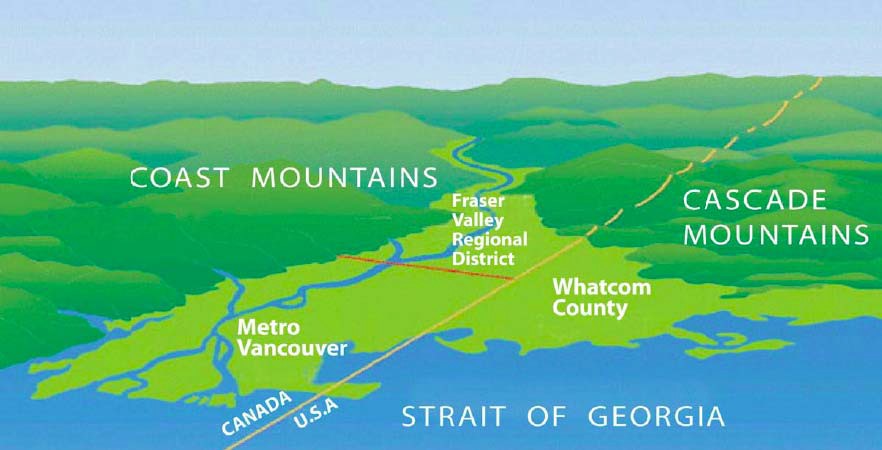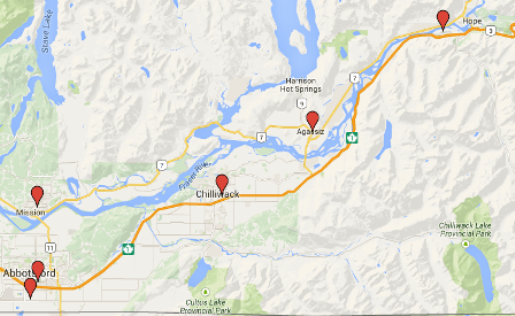Background
The FVRD is located in the Lower Fraser Valley airshed. The surrounding mountain ranges, combined with prevailing wind and weather patterns can push and trap pollutants in the eastern portion of the valley.

Lower Fraser Valley Airshed.
Source: 2005 Lower Fraser Valley Emissions Inventory and Forecast and Backcast
-
What is Air Quality?
Clean, unpolluted air is considered to have good air quality. Air pollutants come from a variety of sources, including vehicles, planes, ships, backyard fires, wildfires, and industrial and manufacturing activities. As the air becomes polluted, humans suffer from its health effects. It also has negative impacts on plants and on the environment.
-
What is an airshed and how does weather affect it?
An airshed is an area where the movement of air, and air pollutants, can be hindered by local geographical features such as mountains and by weather conditions. The most obvious example in British Columbia is a mountain valley.
A temperature inversion occurs when the air near the surface of the earth is cooler than the warmer air above. The cooler air is heavier and will not mix with the warmer air. This happens most often during calm, stagnant conditions. During an inversion, pollutants concentrate in the lower, cooler air and remain trapped within the air that we breathe.
-
How does air quality relate to climate change?
Greenhouse Gases (GHGs) trap longwave radiation in the atmosphere, keeping the earth's surface warmer than it would be if they were not present. Excessive amounts of GHGs in the atmosphere are the fundamental cause of the greenhouse effect and consequently climate change. Three of the most abundant GHGs are carbon dioxide (CO2), methane (CH4), and nitrous oxide (N2O).
-
How does air pollution affect the environment?
Air pollution can directly contaminate the surface of bodies of water and soil. This can kill crops or reduce their yield, kill young trees and other plants, and also change the soil composition. Air pollution can even cause building and monuments to decay.
-
How does air pollution affect health?
Your lungs breathe in the air around you. The average adult takes about 20,000 breaths per day, and children breathe even more. Air pollution has a negative effect on your respiratory system and cardiovascular system. Older adults, young babies, and people with pre‐existing illnesses such as diabetes, lung disease (asthma, chronic bronchitis, emphysema, lung cancer) or heart disease will have greater sensitivity to air pollution.
It is the smallest particles that may be the most dangerous, such as fine particulate matter (PM2.5). Due to their small size, which is smaller than the diameter of a human hair, PM2.5 can get stuck in the lungs or be absorbed directly into the bloodstream. Learn more about air quality on your health.
-
How do I find out what the air pollution level is today?
The Air Quality Health Index (AQHI) is a tool that helps you understand the air quality health risks for a particular area for that day. It is measured on a scale from 1 (low risk) to 10+ (high risk). It also guides people on how to limit their exposure to air pollution by adjusting their outdoor activity during the episodes of poor air quality. The AQHI is particularly useful to those who are sensitive to air pollution or people at risk. It is calculated from concentrations of ozone (O3), particulate matter (PM2.5, PM10), and nitrogen dioxide (NO2).
-
Is our air quality being monitored?
Air quality is monitored at a network of stations throughout the region which are equipped with instrumentation to measure air pollutants. The monitored pollutants may include:
- particulate matter (PM2.5, PM10),
- ozone (O3),
- sulfur dioxide (SO2),
- nitrogen oxides (NOX),
- carbon monoxide (CO),
- ammonia (NH3) and
- volatile organic compounds (VOC).
There are six monitoring stations within the FVRD: Abbotsford (2), Agassiz, Chilliwack, Hope and Mission. Real-time air quality and weather data is collected and displayed collaboratively through the Lower Fraser Valley Air Quality Monitoring Network, which has several partners including Metro Vancouver, Environment Canada and the BC Ministry of Environment.



